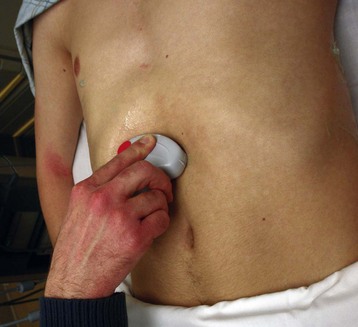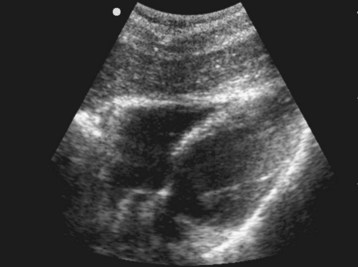9 Sonography for Trauma
• Focused abdominal sonography for trauma (FAST) is sensitive and specific for the detection of intraperitoneal free fluid, but it has poor results when used in an attempt to localize solid organ injury.
• The indications for FAST have expanded to include the evaluation of patients with normotensive blunt trauma and penetrating trauma.
• FAST can be learned quickly by most emergency physicians, although its chief limitation is that it is operator dependent.
FAST Examination
Literature Review
Multiple studies have demonstrated the utility of FAST for the evaluation of patients after blunt abdominal trauma. One of the first studies to highlight FAST by EPs was performed by Ma and Mateer in 1995. This study evaluated ultrasound for detection of free fluid not only in the peritoneum but also in the pericardium, the retroperitoneal space, and the pleural cavity. The authors evaluated a total of 975 cavities and calculated a sensitivity of 90%, a specificity of 99%, and an accuracy of 99%.1 This study demonstrated that with training, EPs are capable of identifying free fluid with high sensitivity and specificity.
Subsequent studies focusing on FAST have found variable results ranging from sensitivities of 79% to 100% and specificities of 95.6% to 100%.2–5 Although calculated sensitivities and specificities have been variable across studies, one finding that seems consistent is that both sensitivity and specificity appear to increase in hypotensive patients.6
Conversely, a Cochran review published in 2005 found “insufficient evidence from RCTs [randomized controlled trials] to justify promotion of ultrasound-based clinical pathways in diagnosing patients with suspected blunt abdominal trauma.”7 These findings have been controversial, and a similar literature review by Melniker found “the FAST examination, adequately completed, is a nearly perfect test for predicting a ‘Need for OR’ in patients with blunt torso trauma.”8
One finding that has appeared consistently in most studies is that although FAST is sensitive and specific for the detection of intraperitoneal free fluid, it has poor results when used in attempts to localize solid organ injury.9,10
Ultrasound has been shown to be a reliable study for the evaluation of traumatic pericardial effusions. Mandavia et al. found that EPs with training in echocardiography had a sensitivity of 96%, a specificity of 98%, and an overall accuracy of 97.5% for this indication.11
How to Perform a FAST Examination
A low-frequency transducer is typically used to ensure proper depth of penetration.
Subxiphoid View
To evaluate the subxiphoid view of the heart, the transducer is placed just below the subxiphoid process and aimed toward the patient’s left shoulder (Fig. 9.1). It is frequently necessary to apply some pressure to the upper part of the patient’s abdomen to enable the sonographer to look “up” into the patient’s chest. It is also helpful to think of the transducer as a flashlight and imagine shining it toward the left side of the patient’s chest. Another helpful tip for beginning sonographers is to increase the depth if at first the heart is not seen in full. A four-chamber view of the heart should be sought (Fig. 9.2). Specifically, the bright white (or hyperechoic) outline of the pericardium should be sought to evaluate for the presence of pericardial effusion.
Right Upper Quadrant
The right upper quadrant should be evaluated in both the coronal and transverse planes. To begin, the transducer is placed on the patient’s midaxillary line between the 8th and 11th ribs (Fig. 9.3). This position should be adjusted as needed to overcome rib shadowing and to obtain the best image possible. Aiming the indicator toward the patient’s head will yield a coronal image. The interface between the liver and kidney (pouch of Morison) and the potential spaces around this area should be thoroughly evaluated for the presence of free fluid (Fig. 9.4). This can be done by sweeping the transducer anteriorly and posteriorly. Moving the transducer superiorly a rib space or two will usually allow a view of the echogenic diaphragm curving over the dome of the liver. The area superior to the diaphragm, the costophrenic recess, can be evaluated for the presence of pleural fluid as well. Once a coronal image has been obtained, the transducer should be rotated so that the indicator points toward the patient’s right to obtain a transverse view. Although such placement frequently provides an adequate view, it is often helpful to angle the transducer on a slightly oblique plane so that it fits into the intercostal space and thus limits rib shadowing. Once the liver and kidney are seen, sweeping the transducer superiorly and inferiorly offers a full evaluation of areas in which free fluid may collect.
Left Upper Quadrant
The left upper quadrant is evaluated in much the same manner as the right upper quadrant. One important distinction is that the left kidney is usually found in a more posterior and superior location. Therefore, to obtain a coronal image, the transducer is placed in the posterior midaxillary line between the 8th and 11th ribs (Fig. 9.5). The indicator should be pointing toward the patient’s head. It is particularly important not only to evaluate the interface between the kidney and spleen but also to seek the interface between the spleen and diaphragm (Fig. 9.6
Stay updated, free articles. Join our Telegram channel

Full access? Get Clinical Tree










